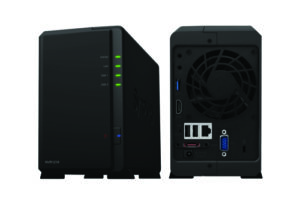 This recorder is based on a NAS style box that can accept one or two hard drives of up to 10TB capacity. This storage can be increased by the addition of an external expansion drive unit. Before operation, software must first be loaded from a supplied USB memory stick or the Synology website.
This recorder is based on a NAS style box that can accept one or two hard drives of up to 10TB capacity. This storage can be increased by the addition of an external expansion drive unit. Before operation, software must first be loaded from a supplied USB memory stick or the Synology website.
The NVR was supplied with no hard drive fitted and documentation limited to a pictorial Quick Installation Guide that covers how to fit a drive and the supplied memory device. While additional documentation was available on the company’s website this did not include an operating manual, just an installation manual. The PC viewing software was found to include a useful help file but this feature was not available on the device’s output display.
The NVR is given a default four camera licence and this can be increased to a maximum of twelve. Using H.264 the device’s bandwidth can support up to twelve cameras at 720p at 30fps. This drops to ten cameras at 1080p at 10fps, then 6 x 3MP cameras or 4 x 5MP cameras, both also at 10fps. Power is fed from an external 12v 5A in-line power supply.
Getting started
First a suitable drive must be fitted; a list of compatible drives is given on the supplier’s website with guidance on suitability of drive types with recommendations for Surveillance or Enterprise drives designed for 24-hour write cycles and vibration tolerance. A small extra bracket is provided in case of drives with only four mounting holes not six. Next the installation ‘Dongle’ and a mouse are inserted into the identified USB sockets. One USB 3 port is available and is recommended for the installation dongle and two additional USB 2 ports are available for a mouse (not supplied) and other devices. Next the network lead and a connection to an HDMI monitor should be made and then the power supply can be connected.
All components are mounted on a main board with a removeable sub-board providing the two SATA drive connectors. For the testing, a 1TB drive was installed.
A 3” fan draws air through the case and out through the rear panel. The system reported an operating temperature of 34°C which matched the observed temperature of the majority of components being below 35°C after a number of hours operation.
Software
The NVR has no firmware loaded when supplied but the installation process from the supplied memory stick is relatively quick and trouble free. PC software is available in the form of Surveillance Station but this must be downloaded from the Synology website. This presents a similar desktop window and allows recordings to be downloaded to the PC.
Operation
The NVR can be operated as a stand-alone device using a mouse and the HDMI monitor output. The IP Camera option is used for entering new cameras onto the system. It was observed that the desktop display had a distinctly pink hue until cameras were added at which point the desktop took on a more normal white banner and window display colour, however this was not observed with a later re-installation of firmware. Cameras can be individually or batch entered and edited and are selected from an impressive range of manufacturers and models or using a generic ONVIF profile. The manufacturer specific settings allowed some very old IP cameras to be entered for recorder testing that would normally not be compatible with modern NVRs.
While the desktop format is based on a Linux Graphical User style, it is relatively easy for users accustomed to Microsoft Windows to navigate.
Read the full review in the January 2018 edition of PSI magazine

